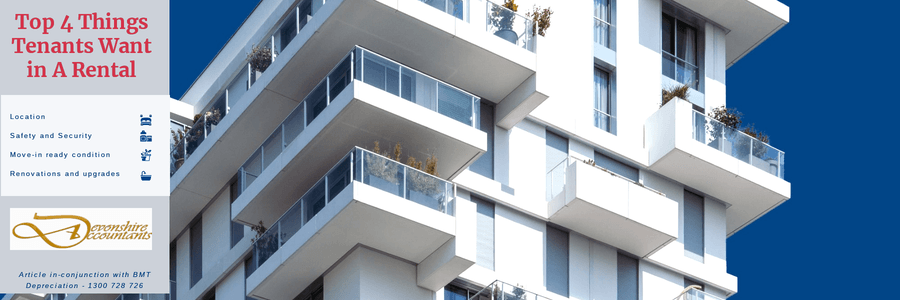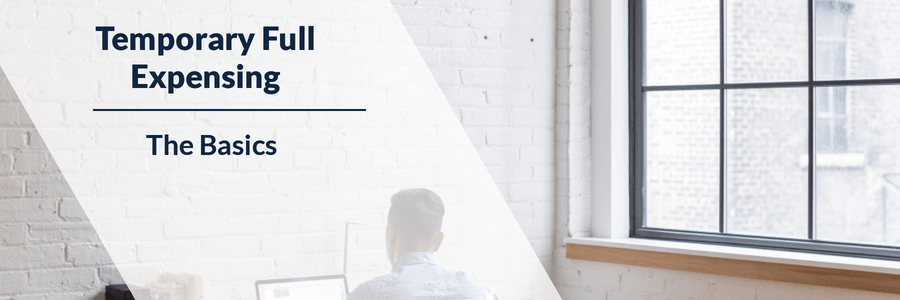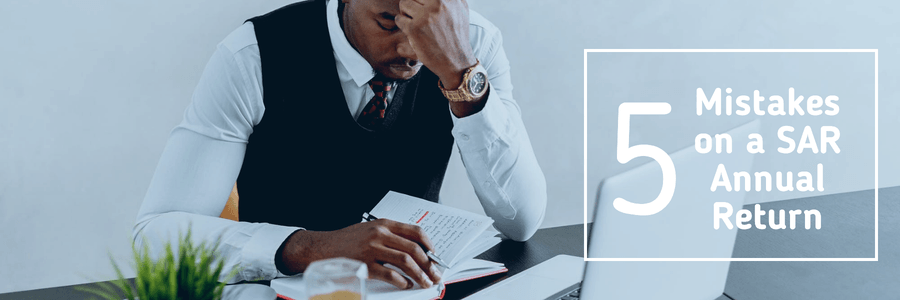BLOG
Welcome to Devonshire Accountants Blog Page

By Raj Rana
•
13 Dec, 2021
Whether you're thinking about purchasing your first investment property, adding to your portfolio or turning your home into an investment, you need to know what tenants want. 1. Location It's impossible to know what a specific tenant will want location-wise. But this is where it's important to identify your target tenant market and what they want in their location. For example,, families may be looking for school districts, while students will be looking for accommodation close to learning institutions or with transport routes. 2. Safety and security Everyone needs to feel safe in their own home. Tenants will want a property with secure locks and doors, lockable windows and window coverings for added privacy. Looking into the safety of an area could also be a good move when finding an investment property if you're unfamiliar with the area. Research crime statistics and history to get a gauge on the area and how this may impact potential tenant demand. 3. Move-in ready condition The last thing a tenant wants to do is submit maintenance and repair requests while they are in the process of moving house. Getting all the little things sorted before they move in is a must. Work through any items with your property manager and ensure everything is covered. The benefit of doing this early means a more comprehensive entry condition report, plus you get to claim any maintenance and repair request as an instant tax deduction in the same financial year. 4. Renovations and upgrades A modern and aesthetically appealing space doesn't just appeal to more tenants, it allows you to charge a higher rental rate to improve the cash flow of your investment. The roadblock to this is always going to be the costs involved. Renovations and upgrading a property isn't cheap. But claiming property depreciation as a tax deduction at take time can make a big difference to cash flow. Depreciation is the natural wear and tear of property and assets over time, and is the second highest tax deduction available to investors after loan interest repayments. When you renovate a property or upgrade an appliance like a dishwasher with a new one, you can claim depreciation on the improvement. Depreciation is claimed each financial year across an asset's or structure's depreciable lifetime. But just because something needs to be depreciated doesn't mean you have to wait years to claim back the full amount. Depreciation incentives like the 'immediate deductions' allows you to instantly claim some assets that cost less than $300. For example, if you purchased a new ceiling fan that costs $250 for your investment property, you could claim its full cost instantly in the same financial year. To learn more about how depreciation works for renovations, contact our office on 07 3800 0807 Article Credit in conjunction with BMT Tax Depreciation. BMT Tax Depreciation has been working in the property investment industry for over twenty years.

By Raj Rana
•
10 May, 2021
Are you thinking about moving to a new house but want to hold onto your current property? Turning it into an investment for the short or long-term can be a good option while increasing your cash flow. But before you do, here are seven things you need to do before renting out your home. 1. Speak to the team at Devonshire Accountants Speak to our expertise team that will guide you through the various deductions available and any negative gearing calculations in detail. Its an important step in planning the tax implications that you can have when preparing your tax return. Our team will also fully explain the deductions available and compliance that is required by you towards the Australian Taxation Office (ATO) 2. De-personalise the property While the property is still yours, it's important to make your future tenants feel like it's their own. Happy tenants will go the extra mile to look after it. This means removing the personal items in the property from when it was your home. Remove the kids' height measurements from the walls, the family dog's outdoor kennel and have all mail redirected. 3. Fix those 'maintenance request' risks early If it's broken, fix it. It mightn't seem like a big issue – maybe it's just a small crack in the wall or peeling paint – but putting it off is just creating a future problem for yourself. Making it a future problem may also make the small issue into a big one. For example, a tired-looking deck now could just need re-oiling but leaving it for later could result in a full (and costly) deck replacement. 4. Do smart improvements If you're thinking about making some slight improvements to your property before renting it out, keep improving your rental return and tenants in mind. Smart improvements will increase tenant interest and the amount of rent you can charge. For example, if your tenant market is young families, installing a bathtub can be a good choice. Easy-to-clean benchtops and flooring options are always a winner with tenants, too. An additional point to keep in mind is the timing of the improvement. If you make an improvement while you still live in the property, you won't be able to claim depreciation on any new plant and equipment assets. So it might be best to wait until you have moved out. 5. Clean Your future tenants need to leave the property in the state it was first leased in (allowing for fair wear and tear). Your property manager will complete a condition report to ensure this happens. To make sure you can keep your tenants accountable, it's important to also do your own part. Your property manager could also recommend a reputable cleaner to get the job done. 6. Update your insurance policy Your owner-occupier home and contents insurance won't cut it when the property is an investment. You need the appropriate landlord insurance policy. Landlord insurance will cover you for many insured events, including those unique to investment properties like tenant damage and loss of rent. Insurance policies differ between providers, so it's important to read the fine print when choosing the best-suited policy for you. 7. Get a depreciation estimate Too many people are missing out on claiming thousands in depreciation deductions. Depreciation is the natural wear and tear of a property and its assets over time. As a property investor to-be, you can claim this depreciation as a tax deduction each financial year once the property is available for rent. When you make your home an investment, contact a specialist quantity surveyor, such as BMT Tax Depreciation, to provide a free depreciation estimate. This could uncover thousands in deductions that you could claim. To learn more about depreciation estimates, please contact BMT Contact us today on 07 3800 0807 to discuss how we can assist you with your Investment property.

By Raj Rana
•
12 Apr, 2021
As you start your property investing journey, you will find different opinions in every corner and an overwhelming amount of information. The secret to getting on the front foot is keeping it simple. With over twenty years of experience in the property industry, BMT Tax Depreciation and Devonshire Chartered Accountants share their top five tips for new investors. Determine your investment strategy It's important to establish your game plan. While this may change over time, having a baseline is essential. Some examples of investment strategies include purchasing multiple properties in a relatively short period of time, across geographical locations to mitigate risk or building a portfolio to support the retirement phase. Take the time to determine your strategy before looking for a property. Ask yourself what the end goal is and how your choice in properties can help you get there. Do the research You can't predict what is going to happen in the property market, but you need to have a solid idea of the market you're joining. The first step is understanding the location you're entering as this will help you understand the type of return you can expect and the specific tenant market. Looking at the property trends in the area, demand and supply, the local demographics and employment rates are some key indicators of how the property will perform. The second step is researching the property itself. Not only do you need to ensure the property fits into your budget, but you also need to understand how it will impact your cash flow in the long term. Tools such as PropCalc can help you make an informed decision by showing how the purchase will affect your cash flow. This tool allows you to customise data such as income, expenses and tax deductions for the property. You can also compare properties, view and save a range of personalised property reports. Head over heart approach Mortgages are a big commitment, and this sometimes leads to new investors choosing properties they like or could even see themselves living in. However, it's important to remember that this is an investment decision, and you need to take a practical approach. This means you're looking for a property that is likely to be leased out consistently. Determining your 'ideal' tenant in your investment strategy is essential to do this successfully. For example, if your ideal tenant is a single working professional or couple, a low maintenance property is preferred. Meanwhile, if you're targeting small families a property with a yard, multiple bedrooms and a practical living space is ideal. Build your investment team Surrounding yourself with an experienced and reliable property investment team is essential to your success. These are the people that will make your life easier throughout your investing journey. The people in this team depends on your scenario, but an accountant and property manager are a good place to start. Your accountant is there to manage your taxes and to help you maximise your property's cash flow while ensuring full compliance is maintained. Your property manager oversees the day-to-day operations such as finding tenants, collecting rent and responding to maintenance or repair requests. Both your accountant and property manager will also work with a specialist quantity surveyor. A quantity surveyor gets involved when you purchase the property and if you make any improvements. They prepare the tax depreciation schedule to ensure you can claim depreciation deductions for the lifetime of the property (up to forty years). But what is depreciation and why do you need this schedule? Depreciation is the natural wear and tear of a property and assets over time. Only owners of income-producing properties can claim depreciation as a tax deduction each year and this is where the schedule comes in. The tax depreciation schedule identifies everything on the property that can be depreciated. An accountant uses this schedule to determine the depreciation deductions each financial year. Article Credit - BMT Depreciation Experts Contact Devonshire Accountants today on 07 3800 0807 to discuss how we can assist you with your Investment property.

By Raj Rana
•
31 Mar, 2021
Businesses with an aggregated turnover of less than $5 billion can immediately deduct the business portion of the cost of eligible new depreciating assets. Corporate tax entities unable to meet the $5 billion turnover test may still be eligible for temporary full expensing under the alternative income test. The eligible new assets must be first held, and first used or installed ready for use for a taxable purpose, between 7.30pm AEDT on 6 October 2020 and 30 June 2022. For businesses with an aggregated turnover of less than $50 million, temporary full expensing also applies to the business portion of eligible second-hand depreciating assets. Businesses can also immediately deduct the business portion of the cost of improvements to eligible depreciating assets (and to assets acquired before 7.30pm AEDT on 6 October 2020 that would otherwise be eligible assets) if those costs are incurred between 7.30pm AEDT on 6 October 2020 and 30 June 2022. You can make a choice to opt-out of temporary full expensing for an income year on an asset-by-asset basis if you are not using the simplified depreciation rules. If you are a small business that chooses to use the simplified depreciation rules, you apply the temporary full expensing rules with some modifications. This includes deducting the balance of your small business pool at the end of an income year ending between 6 October 2020 and 30 June 2022 Contact Devonshire Accountants 07 3800 0807 to discuss the options available to your business

By Raj Rana
•
30 Mar, 2021
Everyone makes mistakes. When it comes to preparing and lodging your self-managed super fund (SMSF) annual return (SAR), you want to get it right. Below are the top five mistakes we've identified and some tips on how to avoid them. Not including a bank account in your funds name You need a bank account in your fund's name to manage the SMSF operations and to accept contributions, rollovers of super and income from investments. You need to report this account when lodging your SAR. The account must be separate from your trustees' individual bank accounts and any related employers' or advisers' bank accounts. This will protect your fund's assets and ensure super payments can be made to your SMSF. Providing an incorrect electronic service address (ESA) An ESA allows your SMSF to receive electronic remittance advice and contributions if you have members receiving super from non-related employers. An ESA consists of alphanumeric characters with a combination of upper and lower case characters and is case sensitive. It's not an email address or the contact details of the SMSF messaging provider. Not valuing SMSF assets at market value SMSF assets need to be reported at market value as at 30 June to prepare your fund's accounts, statements and SAR. If you follow our valuation guidelines , we'll generally accept the valuation you provide. Accurate asset valuation is important to ensure your SMSF retains its complying fund status. Penalties may apply for inaccurate valuations as these can have an impact on your members' balances. Trying to lodge with zero assets An SMSF is not legally established until the fund has assets set aside for the benefit of its members. We won't accept a SAR from an SMSF that has no assets unless the fund is being wound up. If this is your SMSF's first year and you have no assets set aside for the benefit of your members, you can ask us to either cancel your fund's registration or flag the SMSF's record as return not necessary (RNN) Incorrect or no auditor details in SAR Your SMSF must have its financial statements and records audited each year by an approved SMSF auditor prior to lodging the SAR. The approved SMSF auditor must be appointed no less than 45 days before your SAR is due. Make sure you: receive a copy of the audit report before you lodge your SAR. report the correct auditor details on the SAR including the SMSF auditor number, name of auditor and the date the audit was completed. If you lodge your SAR without approved SMSF auditor details, it will be suspended and not recognised as a lodgment. This will impact the complying status of the fund until the SAR is lodged with the required information. If the auditor details are incorrect, you may also be penalised for making a false and misleading statement. Source - Australian Taxation Office Contact us today on 07 3800 0807 to assist you with SMSF Tax Returns

By Raj Rana
•
30 Mar, 2021
Cattle farms, vineyards, sheep stations and poultry farms are just some examples of the common primary production industries across the country. The sometimes-unforgiving Australian climate means those in the business of primary production should always leverage available deductions to help their cash flows. The general rules of depreciation usually apply to assets used in these industries. However the Australian Taxation Office (ATO) has a number of special rules for depreciating the following assets: Water facilities Fencing assets Fodder storage Horticultural plants One set of rules doesn't cover all these assets. Therefore, at BMT we look at each asset individually to ensure its particular rules are applied correctly. Water facilities Dams, tanks, tank stands, bores, wells, irrigation channels, pipes, pumps, water towers and windmills are all examples of water facilities. A primary producer can fully deduct the value (or cost) of a water facility if it was incurred after 7:30pm on 12 May 2015 in the same year. However, previous rules apply if the water facility was purchased before this. This means the owner would instead deduct one-third of the cost in the year of purchase and one-third in each of the following two financial years. Fencing Fencing covers the asset itself and any structural improvement to a fencing structure (e.g. alteration, addition or extension). Like water facilities, a primary producer can fully deduct the value (or cost) of a fence if it was incurred after 7:30pm on 12 May 2015 in the same year. To be eligible, the fencing must be used wholly for carrying on a primary production business. For example, if the business owner also lived on the property in a farmhouse that had a personal garden with fencing, they couldn't claim this. Fodder storage Silos, hay sheds and dried grain bins are just some examples of fodder storage assets. To be eligible for the primary production rules the asset must pass the 'primarily and principally test'. A fodder storage asset will only pass this test if its main purpose is to store fodder. This means if a shed stored farm equipment, but once or twice a year it stored dried grain due to busy seasons, it wouldn't pass the 'primarily and principally' test. If a primary producer purchased or incurred an expense on their fodder storage on or after 19 August 2018, they can immediately deduct the total cost in the same year. This also applies if it was incurred before 19 August 2018 but first used or installed after this date. If a partial deduction has already been claimed in a previous income year, the previous year's tax return will need to be amended to claim a deduction for the full amount in the year it was incurred. But what happens if a primary producer acquired a fodder storage asset in June 2018 and installed it after 19 August 2018? In this scenario, the owner would have deducted one-third of the asset's total in their 2017-18 tax return. However, given the new rules they would need to go back and amend this tax return and claim the amount in full. Horticultural plants Some examples of horticultural plants include grapevines, herbs and apple trees. Primary producers using these types of plants in the business of horticulture can claim depreciation on them. This is provided that they own the plant, and the expense was incurred after 9 May 1995 (or 1 October 2004 for grapevines). The deduction is based on the total cost of establishing the eligible horticultural plant. Some of these costs can include acquiring and planting seeds, ploughing, fertilising and soil enhancement. The effective life of the plant is what determines its depreciation. Primary producers can work out the effective life of a plant or refer to Tax Ruling 2020/3. An instant full deduction of the total cost is only available in the plant's first commercial season if the effective life is less than three years. However, it's important to note that if the primary producer is also a small business entity, they must use the uniform capital allowance rules to depreciate any horticultural plant. Primary production assets and temporary full expensing Since the introduction of the temporary full expensing policy, we have received many enquiries regarding how this policy works for primary production assets that usually qualify for the special rules. These assets are excluded from the temporary full expensing policy, unless the primary producer is a small business entity that opts to use the simplified depreciation rules for the assets. Article Credit - BMT Tax Depreciation is Australia's leading supplier of residential and commercial tax depreciation schedules. Contact us today on 07 3800 0807 to discuss how we can help you with Assets Deprecation for Farms

By Raj Rana
•
11 Mar, 2021
The complexity of depreciation unsurprisingly has many scratching their heads. While investors don't need to be depreciation experts, we have answered some of the most common questions on this area of taxation. Q. What is depreciation and how does it work? It's the natural wear and tear of a property and assets over time. While all properties and assets depreciate, depreciation can only be claimed as a tax deduction if the property is income-producing. This means only property investors, commercial owners and businesses can claim depreciation. Depreciation is a tax deduction, so it reduces the owner's taxable income meaning they pay less tax. Depreciation deductions have the potential to boost cash by thousands of dollars. Q. What is a tax depreciation schedule? This is the key to claiming depreciation. A tax depreciation schedule is a report that identifies all available depreciation deductions for the property. The schedule lasts a lifetime, and the preparation cost is 100 per cent tax deductible. Q. Can investors claim depreciation on all types of property? Most properties, both new and old, have depreciation available. There are some myths out there that older properties can't benefit from depreciation, but this isn't always the case. While second-hand properties are impacted by 2017 legislation changes, the owner can still claim depreciation on new assets and any eligible capital works. Q. Why does an investor need to consult with a specialist quantity surveyor? Doesn't an accountant look after things like this? A specialist quantity surveyor, such as BMT, prepares the tax depreciation schedule that an accountant uses to determine depreciation deductions. Consulting with both a specialist quantity surveyor and an accountant will help make an investment strategy bulletproof. Q. What's the difference between a repair and an improvement? An improvement enhances something beyond its original state, such as replacing a wooden fence with new Colorbond steel fencing. A repair's purpose is to fix something, for example patching a hole in a wall or repairing pipes. There's also a big difference between the two when it comes to claiming them. Improvements must be depreciated using either capital works deductions or as plant and equipment. Meanwhile, repairs or maintenance can be claimed as a full expense in the year it was paid. Q. What areas does a BMT Tax Depreciation cover? BMT offers an Australian-wide service, so no matter if the property is in Sydney or Alice Springs, the team can prepare a tax depreciation schedule. Their specialist site inspection team inspects all types of properties in the schedule preparation process to ensure all deductions are identified. Article Credit - BMT Tax Depreciation is Australia's leading supplier of residential and commercial tax depreciation schedules. Contact us today on 07 3800 0807 to assist you with Rental Property Depreciation.
By Raj Rana
•
14 Oct, 2020
Jobmaker Hiring Credit
On 6 October 2020 as part of the 2020–21 Budget, the government announced a new incentive for businesses to employ additional young job seekers called the JobMaker Hiring Credit. The JobMaker Hiring Credit will be administered by the ATO.
Eligible employers will have access to a JobMaker Hiring Credit for each new job they create over the 12 months from 7 October 2020, for which they hire an eligible employee, for a maximum claim period of 12 months from their employment start date.
Employers will register with the ATO and make claims quarterly, with claims commencing in February 2021.
This measure is subject to the passage of legislation.
The JobMaker Hiring Credit will be:
$200 per week for each eligible employee aged 16 to 29
$100 per week for each eligible employee aged 30 to
Contact us today on 07 3800 0807 to assist you with the eligibility requirements of Jobmaker Hiring Credit
...or make an appointment
If you would like to meet with one of our team to discuss your financial needs, please feel free to book an appointment with us.
Copyright Devonshire Accountants ©
| Disclaimer
| Site Map
| Websites for accountants by Wolters Kluwer


